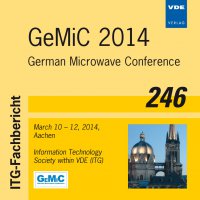Implementation of Antenna Array Systems for Medical Imaging
Konferenz: GeMiC 2014 - German Microwave Conference
10.03.2014 - 12.03.2014 in Aachen, Germany
Tagungsband: GeMiC 2014
Seiten: 4Sprache: EnglischTyp: PDF
Persönliche VDE-Mitglieder erhalten auf diesen Artikel 10% Rabatt
Autoren:
Jalilvand, Malyhe; Vasanelli, Claudia; Kowalewski, Jerzy; Zwick, Thomas (Institut fuer Hochfrequenztechnik und Elektronik, IHE, Karlsruhe Institute of Technology, KIT, Karlsruhe, Germany)
Inhalt:
Two different antenna arrays are designed and fabricated using monopole and folded bowtie antennas as radiating elements for stroke detection. Both arrays are meant to operate in a lossy and high-permittivity matching liquid to reduce reflection at skin-air interface. A coupling medium of average permittivity of 45 is employed which properly emulates the average dielectric properties of human head tissue in the frequency range of 0.5 to 2 GHz. The performance of the two proposed arrays are compared. Experimental results prove that bowtie array shows a lower mutual coupling between adjacent elements and a higher transmission coefficient than monopole array. A deep study about calibration techniques for raw data collection is conducted using experimental results. In particular, the suitability of the incident and scattered calibration techniques for the proposed system is investigated in detail. With regard to experimental results, it is shown that the incident calibration technique suffers from deep notches effect in trasmission coefficient magnitude. A novel frequency selection procedure to mitigate their effect is also proposed and validated. On the other hand, scattered calibration procedure assures better performance, because it is robust to notches effect. The advantage of using a penetrable scatterer (PVC) instead of a PEC cylinder as the reference object for the scatterd technique is proved experimentally.


